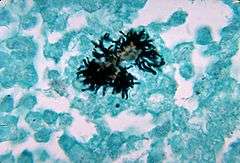Actinomyces naeslundii
Actinomyces naeslundii is a Gram-positive, rod-shaped bacterium found in the mouth of humans. The species has been implicated in periodontal disease, as well as various tooth cavities.[1] In other cases, A. naeslundii is associated with good oral health. It is one of the first bacteria to occupy the oral cavity and colonize the tooth's surface. It has also been isolated from women with bacterial vaginosis.[2]
| Actinomyces naeslundii or Actinomyces oris | |
|---|---|
 | |
| Histopathological changes due to A. naeslundii. | |
| Scientific classification | |
| Kingdom: | |
| Phylum: | |
| Order: | |
| Family: | |
| Genus: | |
| Species: | A. naeslundii |
| Binomial name | |
| Actinomyces naeslundii Thompson & Lovestedt 1951 | |
Description
A. naeslundii appears Gram-positive and pleomorphic by microscopy. It does not form spores, and is considered anaerobic or microaerophilic.[3]
In 2009, the species A. naeslundi was split. Bacteria formerly known as "Actinomyces naeslundi genospecies 2" were reclassified under the new species name Actinomyces oris. Those formerly known as "Actinomyces naeslundi genospecies WVA 963" were reclassified as Actinomyces johnsonii.[3]
Role in disease
Many species of the genus Actinomyces, including A. naeslundii, cause a chronic disease called actinomycosis, which is characterized by swelling and formation of an abscess which may exude pus. This can be accompanied by tissue fibrosis.[4]
Infections of the mouth, face, and neck are the most commonly recognized infections; however, the thoracic region, abdomen, pelvis, and the central nervous system can also be involved.[1]
References
- Nanna Sarkonen (August 2007). "Oral Actinomyces Species in Health and Disease: Identification, Occurrence and Importance of Early Colonization" (PDF). National Public Health Institute, Helsinki, Finland. Retrieved 24 July 2016.
- Africa, Charlene; Nel, Janske; Stemmet, Megan (2014). "Anaerobes and Bacterial Vaginosis in Pregnancy: Virulence Factors Contributing to Vaginal Colonisation". International Journal of Environmental Research and Public Health. 11 (7): 6979–7000. doi:10.3390/ijerph110706979. ISSN 1660-4601. PMC 4113856. PMID 25014248.
- Henssge, U.; Do, T.; Radford, D. R.; Gilbert, S. C.; Clark, D.; Beighton, D. (2009). "Emended description of Actinomyces naeslundii and descriptions of Actinomyces oris sp. nov. And Actinomyces johnsonii sp. nov., previously identified as Actinomyces naeslundii genospecies 1, 2 and WVA 963". International Journal of Systematic and Evolutionary Microbiology. 59 (3): 509–16. doi:10.1099/ijs.0.000950-0. PMC 2884933. PMID 19244431.
- Quinonez JM. "Pediatric Actinomycosis". Medscape. Retrieved 22 May 2016.
External links
- Actinomyces naeslundii MG1 Genome Page
- Type strain of Actinomyces naeslundii at BacDive - the Bacterial Diversity Metadatabase